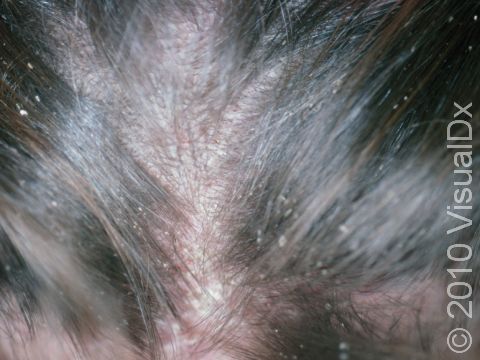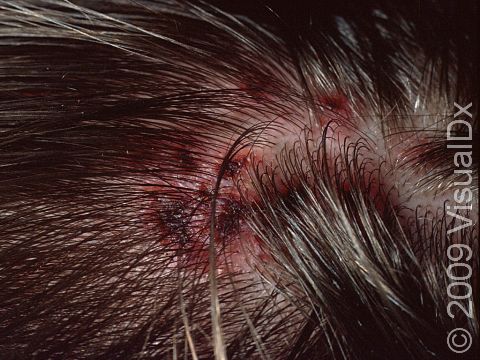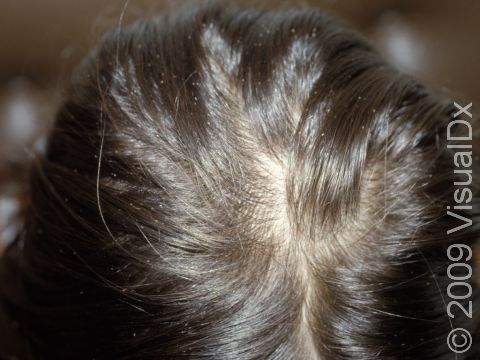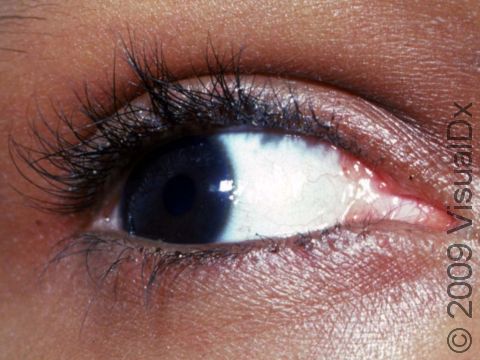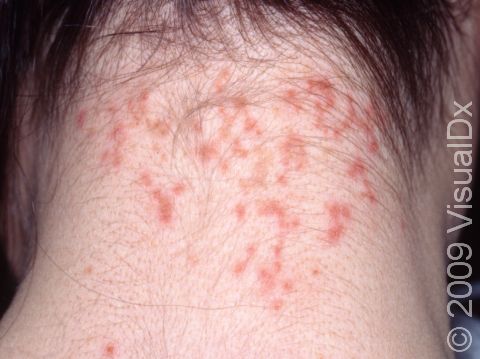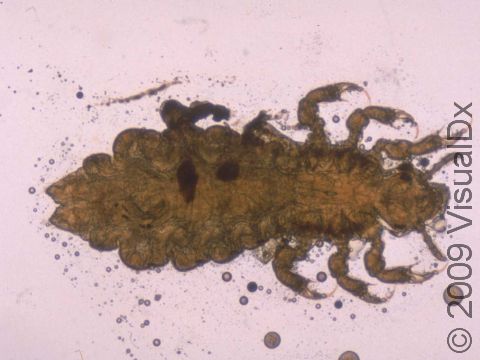Head Lice (Pediculosis Capitis)
Head lice (pediculosis capitis) is a common, highly contagious infection that often occurs in nurseries, day care centers, and schools. It is caused by infestation with the human head louse, Pediculus humanus capitis, and it is usually very itchy.
Lice are very small insects that feed on human blood. The female louse attaches her eggs (nits) to the base of the hair near the scalp, and the nits hatch 7–10 days later. While the adult louse cannot survive for more than 2 days off the human head, a nit can stay alive for up to 10 days off the body (for example, on clothes, hairbrushes, or carpets). Lice are spread from child to child by close head-to-head contact and by sharing belongings that are infested with lice.
Who's At Risk?
Head lice can occur in anyone, but children aged 3–11 are most likely to become infested. All socioeconomic groups can be affected, and infestation is not related to the cleanliness of the person or their environment. Because the louse’s claws are better able to grasp certain hair types more than others, those with course, curly hair are affected less often than those with smoother hair types. In addition, girls are more likely to have head lice than boys, possibly because they tend to have longer hair. Head lice infestations are most often seen in situations in which there is close personal contact, such as schools, home, playgrounds, sports, and camp. Lice eat only human blood. Therefore, pets and other animals do not spread the infection.
Signs & Symptoms
Moving lice or nonmoving nits may be seen on the scalp and hair. Each louse is approximately 1–3 mm long and is whitish-gray in color. Lice crawl; they do not jump or fly. Nits are smaller, about 0.5–1 mm, white, and are firmly attached to the hair very close to the scalp.
Small red bumps or sores may be seen on the scalp, neck, and shoulders. Occasionally, the lymph nodes behind the ears or in the neck may be swollen and tender. Lice may sometimes be seen on the eyelashes, causing the eyes to become red and irritated.
Because head lice infestations are quite itchy, scratching is common and may lead to resultant infection or scabbing. In addition to an itching or tickling sensation, children may also be irritable or have difficulty sleeping.
Self-Care Guidelines
If you think your child may have head lice, search for lice and nits using a fine-toothed comb, also called a louse comb, that can be purchased at most drug stores. Examine your child’s scalp with a bright light, and use a magnifying glass if necessary.
If you find lice and/or nits, follow these guidelines:
- Over-the-counter medications for head lice are effective and should be the first treatment you use. These include pyrethrins (A200®, Pronto®, R&C®, RID®, Triple X®) and permethrin lotion 1% (Nix®). Both medicines kill only live lice, not the eggs, so they should be reapplied in 7–10 days to kill newly hatched lice. These treatments are only minimally absorbed through the skin, but they should not be used on children aged younger than 2 years. Use these medicines exactly as directed. These medicines are insecticides and should not be applied in greater quantity or more frequently than recommended.
- Before applying the over-the-counter lotions, do not use conditioner on the hair, as this will coat the hair and protect the lice from the medicine. Also, do not wash the hair for 1–2 days after treatment.
- After the treatment, wear clean clothes and wash other clothes, bed linens, and towels in hot water (greater than 130°F [54.45°C]) and dry them using the hot cycle for at least 20 minutes.
- Wash any object that your child has come into contact with during the past 48 hours in hot water for at least 5 minutes.
- Seal potentially contaminated but nonwashable objects in plastic bags for 2 weeks. (The lice will die within 2 days, and the nits will hatch and die within 2 weeks.)
- Vacuum floors and furniture.
- Examine the hair and scalp of household members and treat them if they are infested.
- Notify the school nurse, teacher, or day-care provider if your child is diagnosed with head lice. Your child can return to school after proper treatment.
- Do not share combs, hairbrushes, hats, towels, bedding, clothing, headphones, stuffed toys, or other items with someone who has head lice.
Note: You do not need to fumigate or fog your home.
Treatments
In order to make a diagnosis of head lice, the doctor must see a louse or a nit on the scalp. Occasionally, what is called a Wood’s lamp is used to look for lice and nits. During this procedure, the doctor shines a black light at the scalp, and the insects and eggs appear as yellow-green fluorescent spots.
If the doctor confirms that your child does have lice and you have not yet treated the infestation, he/she will likely recommend over-the-counter medications as described in the Self-Care Guidelines section. If you have already used over-the-counter medications and you still see moving lice, your doctor will probably give you a prescription-strength medication. These include the following:
- Malathion lotion 0.5% (Ovide®) – Kills lice and some eggs and can be used only on children aged older than 6 years. Malathion can irritate the skin and is flammable. It can be absorbed into the skin, especially if it is left on the skin for a long time, so follow the application directions exactly.
- Lindane shampoo 1% – This can be toxic and is absorbed into the blood stream and, therefore, is not used much anymore it. This medication is used only when other medications have failed.
- Ivermectin pills – This oral medication is passed to the lice when they eat human blood. Again, this is used only when other medicines have failed.
Visit Urgency
See your child’s doctor if you have any questions about self-care measures or if you continue to see crawling lice 8–12 days after treatment. Your child may need retreatment with a different medicine. Also call the doctor if you see any signs of bacterial infection on the scalp, such as redness, swelling, pain, or pus. Call the doctor before using any louse medicines if you are pregnant.
Trusted Links
References
Bolognia, Jean L., ed. Dermatology, pp.1324-1326. New York: Mosby, 2003.
Centers for Disease Control and Prevention. Head Lice. http://www.cdc.gov/lice/head/index.html. Modified May 16, 2008. Accessed online March 9, 2009.
Freedberg, Irwin M., ed. Fitzpatrick’s Dermatology in General Medicine. 6th ed. pp.2286-2288. New York: McGraw-Hill, 2003.
Stone SP, Goldfarb JN, Bacelieri RE. Scabies, other mites, and Pediculosis. Wolff K, Goldsmith LA, Katz SI, Gilchrest BA, Paller AS, Leffell DJ, eds. Fitzpatrick’s Dermatology in General Medicine. 7th ed. New York, NY: McGraw-Hill; 2008:2029-2037.
Last modified on October 10th, 2022 at 8:38 pm

Not sure what to look for?
Try our new Rash and Skin Condition Finder
